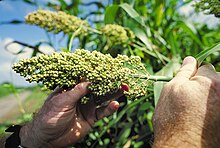Sorghum
From Wikipedia, the free encyclopedia
This article is about the plant genus. For the principal species used in crops, see Sorghum bicolor. For the commercial use of Sorghum species, see Commercial sorghum. For other uses, see Sorghum (disambiguation).
| Sorghum | |
|---|---|
 |
|
| Scientific classification | |
| Kingdom: | Plantae |
| (unranked): | Angiosperms |
| (unranked): | Monocots |
| (unranked): | Commelinids |
| Order: | Poales |
| Family: | Poaceae |
| Subfamily: | Panicoideae |
| Tribe: | Andropogoneae |
| Genus: | Sorghum L. |
| Species | |
|
About 30 species, see text |
|
Contents |
Cultivation and uses

A sorghum field in Central America.
Some species of sorghum can contain levels of hydrogen cyanide, hordenine and nitrates lethal to grazing animals in the early stages of the plant's growth. When stressed by drought or heat, plants can also contain toxic levels of cyanide and/or nitrates at later stages in growth.[3]
Another Sorghum species, Johnson grass (S. halapense), is classified as an invasive species in the US by the Department of Agriculture.[4]
Sorghum vulgare var. technicum is commonly called broomcorn.[5]
Species
- Sorghum almum
- Sorghum amplum
- Sorghum angustum
- Sorghum arundinaceum
- Sorghum bicolor — cultivated sorghum, often individually called sorghum. Also known as durra, jowari or milo.
- Sorghum bicolor subsp. drummondii — Sudan grass
- Sorghum brachypodum
- Sorghum bulbosum
- Sorghum burmahicum
- Sorghum ecarinatum
- Sorghum exstans
- Sorghum grande
- Sorghum halepense — Johnson grass
- Sorghum interjectum
- Sorghum intrans
- Sorghum laxiflorum
- Sorghum leiocladum
- Sorghum macrospermum
- Sorghum matarankense
- Sorghum nitidum
- Sorghum plumosum
- Sorghum propinquum
- Sorghum purpureosericeum
- Sorghum stipoideum
- Sorghum timorense
- Sorghum trichocladum
- Sorghum versicolor
- Sorghum verticiliflorum
- Sorghum vulgare var. technicum — broomcorn
Hybrids
- Sorghum × almum
- Sorghum × drummondii
Sorghum genome
In 2009, a team of international researchers announced they had sequenced the sorghum genome.[6][7]See also
- 3-Deoxyanthocyanidin
- Apigeninidin
- Baijiu - Chinese alcoholic beverage distilled from sorghum
- List of antioxidants in food
- Millet
- Push–pull technology pest control strategy for maize and sorghum
References
- ^ Mutegi, Evans; Fabrice Sagnard, Moses Muraya, Ben Kanyenji, Bernard Rono, Caroline Mwongera, Charles Marangu, Joseph Kamau, Heiko Parzies, Santie de Villiers, Kassa Semagn, Pierre Traoré, Maryke Labuschagne (2010-02-01). "Ecogeographical distribution of wild, weedy and cultivated Sorghum bicolor (L.) Moench in Kenya: implications for conservation and crop-to-wild gene flow". Genetic Resources and Crop Evolution 57 (2): 243–253. doi:10.1007/s10722-009-9466-7.
- ^ Sorghum, U.S. Grains Council.
- ^ Cyanide (prussic acid) and nitrate in sorghum crops - managing the risks. Primary industries and fisheries. Queensland Government. http://www.dpi.qld.gov.au/4790_20318.htm. 21 April 2011.
- ^ Johnson Grass, U.S. Department of Agriculture, Accessed 2257 UDT, 12 March, 2009.
- ^ Broomcorn, Alternative Field Crops Manual, Purdue University, Accessed 14 Mar 2011.
- ^ Sequencing of sorghum genome completed EurekAlert, January 28, 2010, Retrieved August 30, 2010
- ^ Paterson, A.; Bowers, J.; Bruggmann, R.; Dubchak, I.; Grimwood, J.; Gundlach, H.; Haberer, G.; Hellsten, U. et al. (2009). "The Sorghum bicolor genome and the diversification of grasses". Nature 457 (7229): 551–556. Bibcode 2009Natur.457..551P. doi:10.1038/nature07723. PMID 19189423.
- Watson, Andrew M. Agricultural Innovation in the Early Islamic World: The Diffusion of Crops and Farming Techniques, 700–1100. Cambridge: Cambridge University Press, 1983. ISBN 0-521-24711-X.
External links
| Wikimedia Commons has media related to: Sorghum |
| Wikibooks Cookbook has a recipe/module on |
| Wikisource has the text of the 1911 Encyclopædia Britannica article Sorghum. |
- Species Profile- Johnsongrass (Sorghum halepense), National Invasive Species Information Center, United States National Agricultural Library. Lists general information and resources for Johnsongrass.
- Crop Wild Relatives Gap Analysis Portal reliable information source on where and what to conserve ex-situ, regarding Sorghum genepool
- FAO Report (1995) "Sorghum and millets in human nutrition"
- FAO "Compendium on post-harvest operations"—Contains discussion on origin, processing and uses of sorghum
- Grain Sorghum Irrigation
- Sorghum on US Grains Council Web Site
- National Grain Sorghum Producers
- National Sweet Sorghum Producers and Processors Association
- Sorghum handbook, US Grain Council
- Sorghum Growth Stages
- Sweet Sorghum Ethanol Association, organization for the promotion and development of sweet Sorghum as a source for biofuels, especially ethanol
- Milo, Grain Sorghum
- Cyanide (prussic acid) and nitrate in sorghum crops - managing the risks

No comments:
Post a Comment